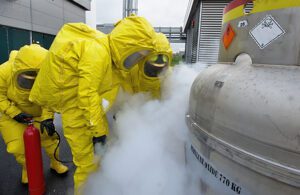
Firefighters training on a simulated ethylene oxide leak [Photo via Adobe Stock]
The largest commercial sterilizers will likely absorb the costs of new ethylene oxide (EtO) regulations — and could consolidate smaller competitors, according to a new analysis from Moody’s Investors Services.
Tighter controls on EtO emissions would increase capital spending and operating costs for all commercial sterilizers who use the toxic gas, which is the most commonly used method for eliminating infection-causing microbes from medical devices.
“Large companies have enough liquidity to fund the significant increase in spending without incremental debt,” Moody’s said in a subscribers-only report this week. “But the higher costs and compliance requirements could make the business less attractive for some small companies.”
The largest commercial sterilizers can absorb the cost of new EtO regulations
The two leading contract sterilizers — Steris and Sotera Health’s Sterigenics — use EtO, as do medical device manufacturers such as Medtronic, Beckton Dickinson, Baxter Stryker and many others.
In total, commercial sterilizers use EtO at 86 facilities in the U.S. To comply with the new regulations, the EPA has estimated those commercial sterilizers will spend approximately $220 million for one-time capital projects and $68 million per year for operations and maintenance.
Moody’s analysts, however, think the true cost will be even higher, citing more than $30 million in equipment upgrades by Sotera and Steris each in recent years.
“Sotera operates eight commercial sterilization facilities in the US and Steris operates nine; together they account for 20% of the total such facilities in the U.S.,” the analysts said int their report. “We believe each company will need to spend an additional $25 million-$35 million on equipment upgrades to make their facilities compliant with the proposed regulations. We also believe the annual operating cost for each of these two companies will increase $5 million-$10 million.”
Those two companies can afford the costs with cash on hand and without taking on additional debt, Moody’s said, based on their revenue, cash flow and capital spending.
“The increased recurring costs will dent the companies’ profit margins, but the impact will be relatively small because EBITDA margins for the two companies exceed 25%,” the report said.
Smaller sterilizers may sell their operations
“By contrast, the additional costs could be untenable for small companies with just one or two sterilization facilities, especially if those facilities are old and operate at smaller scale,” the analysts wrote. “The costs to comply with the new regulations may force some smaller companies to sell their facilities to larger companies and exit the commercial sterilization business.”
Unsaid in the report was that industry consolidation and fewer contract sterilizers could lead to higher costs and longer waits for the medical device manufacturers who hire those firms to sterilize their devices before delivery.
Commercial sterilization firms are already at capacity, and it’s possible the looming regulations and potential legal liabilities have put EtO expansion projects on hold or kept new entrants on the sidelines until companies can weigh finalized regulations against the market opportunity.
The increased focus on the health risks of EtO and critical need for device sterilization capacity is also bringing heightened interest to EtO alternatives.
Just this week, a single-site EtO sterilization firm announced plans to add chlorine dioxide (CD) sterilization to its offerings, while a sterilization startup confirmed conversations with Medtronic on a new CD method that would allow device manufacturers to sterilize on the manufacturing line.
Related: What is electron beam sterilization?